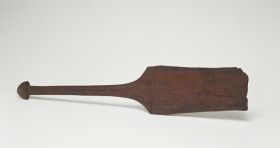Dance paddle paki
wood, Tonga, l. 64–84 cm, Inv. Oz 352
Humphrey No. 233: ‘a steering paddle, having a broad blade, from the said [Friendly] Isles.’ (= Oz 135)
Forster Register B.6: ‘3 short paddles [from Otaheiti]’ (= Oz 352 - Oz 354)
One of four dance paddles made of wood. At the end of the handle, each paddle has a semi-circular pommel. The cross-section of the handles is of a flat oval shape, becoming almost round below the pommel. The blade of Oz 135 is almost rectangular and rounded at the bottom. The blade of Oz 352 is damaged on all sides, especially at the lower end. The blade of Oz 353 is damaged on one side, but that it originally must have been almost rectangular and rounded at the bottom may still be recognised. The blade and part of the handle of Oz 354 are damaged on one side, so that almost half of the blade is missing.
Dance paddles were used in a dance called me’etu’upaki (Kaeppler 1978a: 231). This term means ‘dance’ (me’e) ‘standing’ (tu’u) ‘with paddles’ (paki) (Kaeppler 1967: 509). Cook (in Beaglehole 1967, Illa: 109) described this kind of dance in detail: ‘It was a kind of dance, performed by men and youths of the first rank; ... Any number may perform it, there were in this one hundred and five, each having in his hand an Instrument shaped something like a paddle of 2.5 feet in length, with a small handle and thin blade so that they were very light and the most of them neatly made. With these Instruments, they made many and various flourishes each of which was attended with a different attitude of the body and some different movement or a nother They at first ranged themselves in three lines, and by different movements and motions each man changed his station in such a manner that those who were in the rear came in front. Nor did they remain long in the same form, but these changes were made by pretty quick movements; they at one time extended themselves in one line then formed into a semicircle and lastly into two square Columns, while this last was performing, one of them came and danced a harlequin dance before me with which the whole ended.’
‘During Cook’s time this was the type of formal dance performed on state occasions and in connection with the Tu’i Tonga’s harvest ceremonies’ (Kaeppler 1971: 218). Inken Köhler, Ulrike Rehr, Gundolf Krüger
Sources
Beaglehole, John Cawte, The Journals of Captain James Cook on his Voyages of Discovery The Voyage of the Resolution and Discovery 1776-1780, Hakluyt Society, Extra Series, 36, 1 u. 2. vol. 3, Cambridge University Press, Cambridge, 1955-1967 IIIa and IIIb.
Kaeppler, Adrienne L, ‘Preservation and evolution of form and function in two types of Tongan dance’, in G Highland, RW Force, A Howard and YH Sinoto (eds), Polynesian Culture History, Honolulu, 1967.
Kaeppler, Adrienne L, ‘Eighteenth century Tonga: new interpretations of Tongan society and material culture at the time of Captain Cook’, Man, 1971, vol. 6, no. 2, pp. 204-220, plates 1-6.
Kaeppler, Adrienne L, ‘Artificial Curiosities’ Being An Exposition of Native Manufactures Collected on the Three Pacific Voyages of Captain James Cook RN [Exhibition catalogue], Bishop Museum Press, Honolulu, 1978a.
Related artefacts
Dance paddle paki, Inv. Oz 135
Dance paddle paki, Inv. Oz 353
Dance paddle paki, Inv. Oz 354

